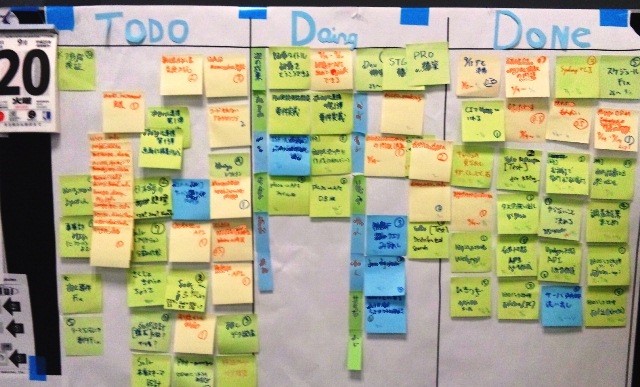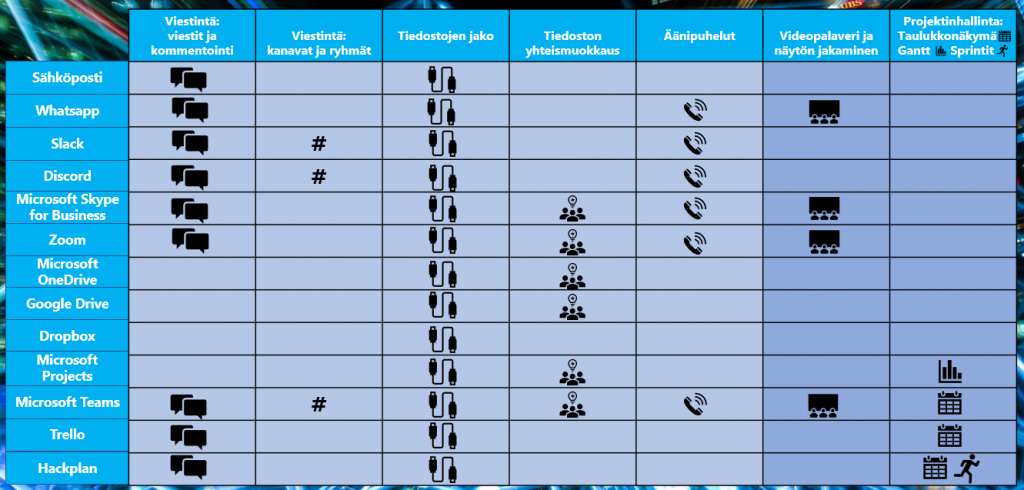Lue tämä suomeksi
Laurea’s Bachelor of Business Administration students took up the role of producer on game development teams in the Capital Region Game Project in the fall of 2019. More familiarly CRGP is being implemented as a joint course with Metropolia, Haaga-Helia, Laurea, Stadin AO and Amiedu. Blog writers Annamaija, Heikki, Henni and Lauri share their experiences during the fall as producers in the game development teams.
Author: Annamaija
Winter’s first snowfall catches drivers by surprise! Hurricane remains come ashore to Finland! Train switch problems cause cancellations to a large number of trains in the morning! A sleepless night and I’m propably about to catch a cold as well.
Sometimes I really wouldn’t like to step outside of the front door in the mornings. What if you could choose to stay at home with a pure conscience? Most of the work that can be done remotely is being done with a computer. You could choose working on your own couch at home, at a terrace in Tenerife or in a lodge at Lapland mountain. No-one would boss around all the time, breath down your neck and try to micromanage everything all the time. You could even make coffee whenever you like.

Pics: Daria Shevtsova – pexels.com (l.), Annamaija Anttila (r.)
One can also earn extra income by doing e.g. website design, Search Engine Optimization, blogging, video editing, bookkeeping, marketing and graphics design or make video blogs. (1) We shouldn’t forget either the game teams where many team members can work together without meeting each others for ages also because of reasons like ”life happens” and ”been busy”.
A long way to work or daily traffics might also cause additional stress. We can consider it would also be an ecolocigal act to reduce car emissions by cutting down some journeys to and from work. (2)
Sounds really easy and effortless! Why not write an email to your boss right away and suggest remote working!
Filling the shoes of a producer or a team leader
The Autumn has arrived and days are getting shorter. A honeymoon after the beginning of the game development project has ended. Team members have caught a flu one after another and some of them have to work to earn a living along with the studies and all. We’re running out of days and hours, so what’s the least I can do?
Working remotely sounds simple and easy to make happen. It’s also been studied that remote work and flexible ways of working possibilities improve job satisfaction. Those even commit to work even 60% better than those work places that don’t have the possibilities. (3, 4) What if we decide as a team that everyone is allowed to work remote if they want? Does anyone miss me (the producer)? Do I have to be on call by the phone and email the whole day? How can I know what everyone is doing remotely? Whether the team members are together or separately, remote or present – time should always be found to leading people.
”You must earn the trust”
False. Each team member should primarly be worth trust. For example Microsoft Corporation has been a strong advocate for telecommuting since 2011 and they have written out a demand for mental presence for working.
Thereafter remote working should be based on trust. Even though the trust exists, it can also be lost. A right to work remotely can also be forbidden if one cannot follow the agreed rules. Of course, also the people present might and can act lazy at the workplace. Jobs can easily be undone when no-one sees. Nothing is completely black and white.
Making remote working possible
Team agreement
When you start working as a team, it’s important to make a team agreement. It gives guidelines how to act in daily life and in exceptional situations as well. It includes the ground rules for when and how you can and must work, what kind of communication and interaction is expected, what to do when you’ll be absent or when you get sick, and how to solve disagreements. The team can also make an agreement about what means are used in communication and how is the one to respond at which faces. The last but not the least it’s important to talk and write down how to encourage and motivate your team members.

As the rules are being written down, you can also consider what kind of knowledge is important and meaningful to whom in order to avoid information overload. The team agreement would be worth to be made as a team with discussing together about the topics. Otherwise if it will be a list of everyone’s visions, without shared understanding the rules can be interpret however one likes. At the worst the ground might be too favourable for unnecessary conflicts. Understanding and mutual agreement is always really vital when making contracts.
Common meetings are an advance improving cooperation with the team members. The meetings should be documented, in other words handled subjects are written down in a memo easily to understand. It would be useful to save the memos in a place accesible to everyone who’s necessary, so one can return to them if there will be a need to check things that have been agreed.
I’ve noticed that the team members in my game team throw ideas day after day and during every single day so it would be profitable if someone in the team could be all ears and write down the important key words at least. The developing and innovation process shouldn’t always have to be started all over from the beginning when things have regularly been gathered on a to do list or a wish list of the game.
Video conferences
Regular, short meetings help reckoning in the good ideas of the virtual team members. Meetings are important for sharing information and improving team spirit as they are working remotely from each other. As the policies for the video meetings are being written down, you might consider for example following things:
- Video conferences. Will the video be turned on or can one attend with voice only? Some might consider body language and reading face expressions really important part of communication.
- How often are the meetings held and how long do those take time?
Will those be daily from 5 to 15 minutes? One hour per week? Even more infrequently held meetings maybe 2 hours? How about a break in between the meeting?
- Will there be any face to face meetings?
How often? What feels natural or necessary for the team members?
- Daily, weekly and montly held meetings: the standard agendas and goals for the meetings? The appeared challenges? How is the progress going on? Time to chat about this and that with each other?
- The responsibilities in a meeting?
Who leads the meeting through and holds on to the schedule? Who will act as a secretary in the meeting and writes down all the matters that’s been dealt with?
- Calming down the meetings?
How is it appropriate to use sell phone? Can one be accessible via phone? Should it be a peaceful place for the meeting? And can one leave the meeting for awhile if necessary?
- The logical progress of the meeting?
Planning in advance and maybe a standard basis for the meetings?
- What presentation materials could be illustrated by pictures and examples?
For example slide shows and other material planned to use in the meetings would be advisable to be tested beforehand in the softwares chosen to be used for the meeting.
- Addressed opportunity for everyone to speak in the meeting?
Could the most quiet ones even give their opinions to the matters to be handled in advance (email, short survey)?

Agile project management methods: scrum meetings
In a short daily mini scrum meetings the team can handle the noticed problems and at the very least. Everyone should commit to be online to join or pass on one’s greetings in the meetings if one cannot participate in. The scrum meetings make it possible to react quickly on challenges noticed, and tasks can be rearranged if needed. (5) In the weekly meetings things are being handled more precisely. What everyone have managed to do in the past week and what’s planned for the upcoming week. It would be worth one’s while going through the problem situations among the team members without pointing any fingers. Anyone can then learn their lessons if needed, and then the problems might not happen again – at least not in the way happened before. Even some the best cooks learn by trial and error.
How to visualize the progress of the project?
If the team members can commit to use common project management tools such as Trello or HacknPlan, each one can follow the progress in the best scenarios in real-time. The traditional Gantt chart can be also used to illustrate how much time is planned for each task. In a project where everyone is working separately it’s important to have the needed information available around the clock. A physical visualization of the ongoing tasks can well be done with the Kanban method, by using for example post-it notes like in the picture below.

I would also like to raise in the spotlight some of the project work and management applications that’s been used in the projects I’ve worked with. In the picture below there are shown the important features which each software or app has to make the project and communication easier to manage.

What does it take to become a remote worker?
I have had a very uncomplicated mental image about working remotely before I familiarized myself with it. In reality the soft skills, such as good self-disciplinity, ability to learn new and motivating oneself, communication and interaction skills and self-guidance are in the key positions. The named features make it possible to work independently and even plan your own work tasks and schedules. Unfortunately everyone isn’t lucky enough to work with the things they dream about, so there will every once in a while come boring tasks on one’s way that also must be done. The amout of experience and know-how and how one has gotten used to work might partly define how much one can take responsibility for oneself and work of one’s own.
I had lived somewhat in a happy bubble in a way before I started studying in the University. I had never thought that almost everything we do in the everyday life is somehow related to regulations by laws.
This morning for example I walked to the train station and stopped at the traffic lights, as one should according to traffic regulations. Young children were taking their heels toward school as the school day was about to begin and they had their compulsory education to complete. I also thought a short while about my own job where I am at a study leave from. Before I got in the train, I made a deal of one kind. I bought a train ticket which entitled me to travel from point A to the point B. During the day I had lunch in a place nearby and I watched how the hard-working people showed up to get well-earned lunch – probably within the time that’s been chosen to use for dining in their collective agreements. In the news on TV there appeared to be just at the right time a few lawmakers aka Members of Parliament.
”Ok, you can work at home tomorrow! See you the day after!”
It won’t be that easy to the employer at all in the working life. Even though it’s not mandatory to write a contract about working remote, it’s recommended really strongly. The employer must arrange suitable devices and softwares, or verify that the employee has sufficient hardware and software with adequate user’s licences to perform work remotely. A remote access is sometimes needed to the to employers net server and working data communications and adequate data security. It’s sometimes also stipulated what you can or cannot do with the employer’s computer. Ergonomics, occupational health care and other things including to working safely must be taken into account. (2)

It’s the employers duty and responsibility to obey the laws and regulations even the employee wouldn’t work present. The progress and quality of work can and must be measured by the employer and react to problems if something occurs. If working hours are being monitored somehow with technical devices, the Working Hours Restriction Act should be followed. For example there must be weekly 35 hour resting period included according to The Laws of Finland. The employee must be respected, and nothing one is doing cannot be kept an eye on unnecessarily.
Here are a few of the laws conserning to remote working:
- Working Hours Act, Finlex.fi PDF file
- Employment Contracts Act, Finlex.fi PDF file
- Act on the Protection of Privacy in Working Life, Finlex.fi PDF file
Ulla Vilkman has presented an observation about the results of a study of working environment in her book ”Etäjohtaminen”(3) made by Työterveyslaitos. The Results state that it is really hard to measure what results an individual makes when working remotely. If the focus would be in a performance of an individual, it might lead into a competition situation, having eye on something one is doing or even jealousy might turn out.
Would you be ready, if only the results of a group would be measured?
Sources of information:
Sources (in Finnish)
The most of the writing is based on Ulla Vilkman’s book ”Etäjohtaminen.” All other sources of information have been tagged with numbers in the text.
- Työntulevaisuus.fi -verkkosivu Referred to 1.11.2019
- Pekkola, J. & Uskelin, L. Etätyöopas työnantajille, PDF-julkaisu Motiva.fi -verkkosivulla. Referred to 1.11.2019
- Vilkman, U. Etäjohtaminen – Tulosta joustavalla työllä. 2016. Alma Talent Oy ja Ulla Vilkman. Referred to 1.11.2019.
- Projektinhallinta.info -verkkosivu.
